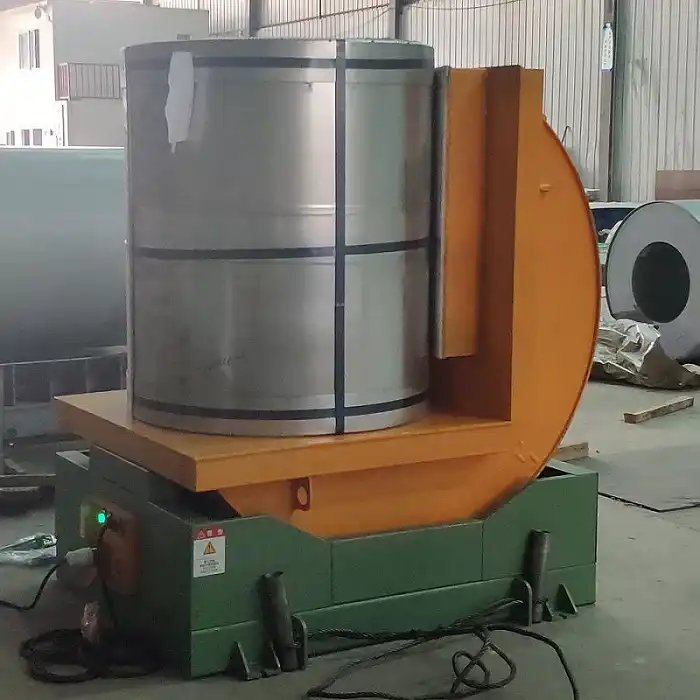Streamlining Metal Coil Handling: Integrating Coil Tilters and Upenders with Conveyor Systems
Efficient and safe material handling is paramount in modern metal fabrication and processing operations. Handling heavy metal coils presents unique challenges, requiring specialized equipment to prevent material damage, ensure worker safety, and maintain production throughput. Integrating coil tilters and coil upender units with conveyor systems offers a robust solution for automating and optimizing this critical process.
Understanding Coil Tilters and Upenders
Coil tilters and upenders are essential pieces of industrial equipment designed to reorient heavy coils, typically made of steel, aluminum, or other metals.
- Coil Tilters: These machines typically rotate a coil 90 degrees, moving it from an "eye-to-the-sky" (vertical bore) position to an "eye-to-the-wall" (horizontal bore) position, or vice versa. This is crucial for loading coils onto machinery like uncoilers or positioning them for storage and transport.
- Coil Upenders (or Inverters): Often used for 180-degree rotation, these devices can flip a coil completely over. This may be necessary for inspection, processing requirements, or specific packaging needs.
The Role of Conveyors in Automated Coil Handling
When integrated with tilters and upenders, conveyor systems create a seamless automated workflow. Powered conveyors transport coils between different stations – receiving, tilting/upending, processing (like slitting or stamping), packaging, and shipping – minimizing manual handling and wait times. This integration is key to achieving high efficiency in continuous production environments.
Key Benefits of Integrated Coil Handling Systems
Automating coil manipulation with tilters, upenders, and conveyors brings significant operational advantages:
- Enhanced Efficiency and Throughput: These systems operate at speeds significantly higher than manual methods. Automated tilting, flipping, and conveying reduce cycle times, allowing for a continuous flow of materials between workstations, directly boosting production output.
- Improved Safety and Reduced Ergonomic Strain: Manually handling heavy coils poses substantial risks of musculoskeletal injuries. Automation drastically reduces the need for operators to physically grasp, lift, and manipulate coils, leading to a safer work environment and potentially lower workers' compensation costs. (Learn more about ergonomic safety in material handling from OSHA).
- Protection of Coil Integrity: Automated systems utilize controlled movements and secure gripping mechanisms. This ensures gentle handling during tilting and flipping, preventing drops, impacts, unwinding, or scratches that can damage valuable coil material and lead to waste.
- Facilitated Inspection and Processing: By automatically positioning coils (e.g., eye-to-the-wall or eye-to-the-sky), operators gain better visibility and access for quality checks, surface inspections, or feeding into subsequent processing equipment without manual repositioning.
- Optimized Workflow and Reduced Bottlenecks: Conveyors ensure a steady, uninterrupted movement of coils between processes. This eliminates pile-ups or waiting times associated with forklift or crane transport, creating a smoother, more predictable production flow and reducing overall lead times.

upender and tilter Design and Operational Considerations
When evaluating or implementing these systems, consider the following:
- Robust Construction: Look for equipment built with heavy-duty industrial components designed for continuous, high-volume operation. Durability is crucial for reliable performance, minimal downtime, and a long service life in demanding industrial settings.
- Capacity and Coil Specifications: Ensure the system is rated for the weight, diameter, width, and material type of the coils you handle.
- Control Systems: Modern systems often feature programmable logic controllers (PLCs) for precise control over speed, rotation angle, and integration with other machinery.
- Footprint and Layout: While handling large coils, these integrated systems can often be designed relatively compactly. Careful layout planning is essential to optimize floor space utilization within your facility. ([Explore internal resources on optimizing plant layout - link placeholder]).
- Safety Features: Essential safety features include proper guarding, emergency stops, load securing mechanisms, and clear operational procedures and training protocols.
Conclusion
Integrating coil tilters, upenders, and conveyor systems represents a significant step towards modernizing metal coil handling. By automating the repositioning and transport of heavy coils, fabrication and processing facilities can achieve substantial improvements in efficiency, worker safety, material protection, and overall workflow optimization. Choosing the right system requires careful consideration of production needs, coil specifications, and safety standards, but the benefits often lead to a more productive and safer operating environment.